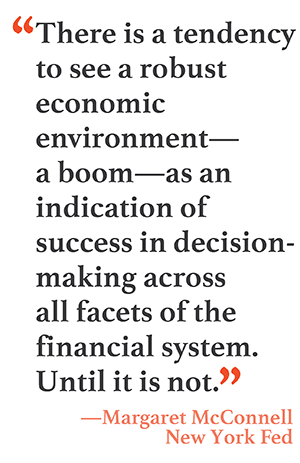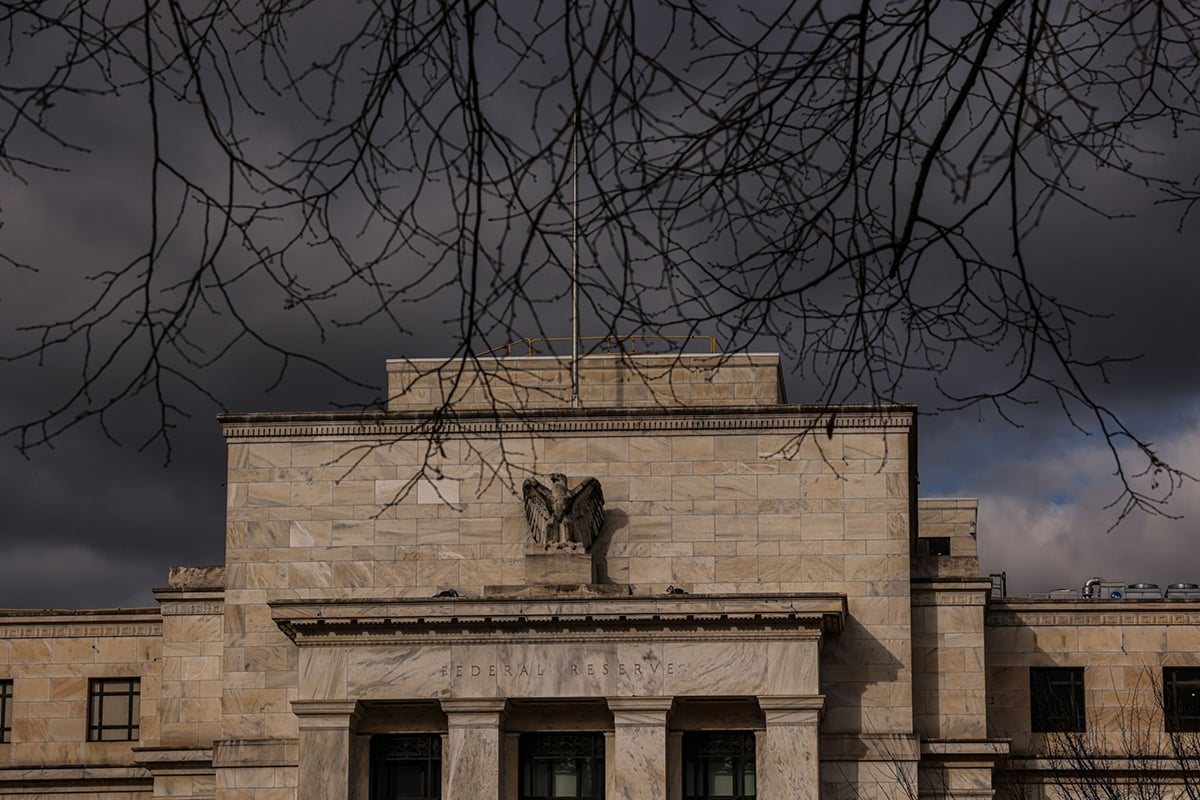 Margaret McConnell often tellsFederal Reserve officials that they should be a lot more confusedthan they let on. That’s her job. She’s head of the AppliedCritical Thinking (ACT) unit, a little-known enclave of the NewYork Fed with a big mandate: to poke holes in the most basicassumptions that central bankers make—assumptions that can lead tobig policy mistakes when they’re wrong.
Margaret McConnell often tellsFederal Reserve officials that they should be a lot more confusedthan they let on. That’s her job. She’s head of the AppliedCritical Thinking (ACT) unit, a little-known enclave of the NewYork Fed with a big mandate: to poke holes in the most basicassumptions that central bankers make—assumptions that can lead tobig policy mistakes when they’re wrong.
The ACT is there to remind the rest of the institution, whosevast research teams are under constant pressure to supply answers,that doubt is legitimate in the face of complex questions, and thatit’s often the things we’re certain about that blow us up. Thebiggest risks aren’t always out there in the markets, in otherwords: Sometimes, they’re right inside the building.
|“I’m interested in shifting the lens,” McConnell—who rarelyappears in public or discusses details of the ACT’s sensitivework—said in an interview last month. “What if what we’re talkingabout as true, is not true? Looking more for puzzles than for thestory you think you know, that’s very hard to do.”
|It’s a deliberately unsettling approach, one that matches themood on the world’s financial markets.
|Record highs for all kinds of assets coexist with an uneasysense that something big could be wrong. Investors are scouring thehorizon in search of the next time bomb, whether it’s leveraged loans or the growing pile of negative-yielding debt.
|McConnell casts the net wider, to include the policy processitself. The financial crisis offers plenty of illustrations. TheFed got housing markets wrong before the crash, and its estimatesof labor resources in the recovery have been off, too. McConnell’sconclusion after 2008 was that economics as practiced at today’scentral banks has embedded blind spots.
|Her bosses agreed, and that’s how the ACT came to exist.McConnell envisioned a unit that would draw on fields such aspsychology, complex systems theory, and design. Former New York FedPresident Bill Dudley liked the idea, and McConnell launched it in2016. There are now about 15 analysts working there.
||
‘Flair for Darkness’
Dudley calls the financial crisis “a bitter failure ofimagination.” Part of that failure happened inside an economicsprofession more inclined to celebrate its successes.
|Fed officials touted the “greatmoderation” they had engineered. Nobel laureate Robert Lucas arguedthat the “central problem of depression prevention has beensolved.” In August 2008, Olivier Blanchard—about to become theInternational Monetary Fund’s (IMF’s) chief economist—proclaimed that “the state of macro isgood.”
| McConnell is the kind of personwho gets worried when everyone else thinks the outlook is bright.She had a “flair for darkness,” Timothy Geithner, the formerTreasury secretary and Dudley’s predecessor as New York Fed chief,said in his crisis memoir “Stress Test.” That’s one reason why hechose her to be one of his closest aides.
McConnell is the kind of personwho gets worried when everyone else thinks the outlook is bright.She had a “flair for darkness,” Timothy Geithner, the formerTreasury secretary and Dudley’s predecessor as New York Fed chief,said in his crisis memoir “Stress Test.” That’s one reason why hechose her to be one of his closest aides.
“She would always ask the awkward question, the uncommonquestion,” Geithner said in an interview. “She was a famouslycurious person and deeply skeptical about received wisdom.”
|The challenge for the Fed is how to harness that kind ofcontrarianism into an institution that’s intensely focused onmission-critical daily tasks. As well as setting the world’s mostimportant interest rate, it oversees financial markets, paymentsystems, and bank balance sheets—all measured in trillions ofdollars.
|The Fed’s legions of Ph.D. economists are trying to spot thelatest trends in trade, investment, prices, or employment so thattheir bosses can make better policy. Some of the New York Fed’sblog and research posts include topics such as large-bank liquidityneeds and how monetary policy announcements impact markets.
|The research process is rigorous and hierarchical, former staffmembers say, with no tolerance for error. They cite an internalsaying: You’re not allowed to make the same mistake once.
|That’s the culture the ACT is trying to change, according toDudley. “You can have a regime where people don’t take risks,” hesays, but then you’ll miss things, maybe important things. “You canbe right in the small. But if you’re not right in the large, it canbe a big mistake.”
||
Changing Fed Tendency to Focus on Congratulations
McConnell, who has a Ph.D. from Ohio State University, joinedthe Fed’s domestic research team in 1996. A few years later, shebegan to take an interest in institutional biases—when she brushedup against them herself.
|She cowrote a paper about why the volatility of GDP growth wasdeclining and pursued a hunch that just-in-time inventorymanagement had changed things. But inside the Fed, she wasencouraged to put more emphasis on the central bank’s newfoundability to stabilize the economy. It was a revealing instance ofconfirmation bias—the kind, McConnell would later point out, thatblinded the Fed to cracks in the financial system before 2008.
|“We have this tendency to want to congratulate ourselves,” shesaid in 2013, in a talk posted on YouTube. “There is a tendency tosee a robust economic environment—a boom—as an indication ofsuccess in decision-making across all facets of the financialsystem. Until it is not.”
|McConnell has experimented with different ways of gettingcolleagues to confront worst-case risks. The ACT sometimes runs wargames, according to people who’ve taken part. The scenario might bea bank that’s desperate for liquidity but lacks collateral in theU.S., or a Treasury default amid debt-ceiling brinksmanship.
|James McAndrews, the New York Fed’s former head of research,recalls one exercise conducted just before an important policydecision. The ACT came up with some fictional news headlines from ayear into the future, to illustrate potential outcomes.
|“It made us take one step back and think about the lifecycle ofan issue,” McAndrews says. The takeaway: “Don’t push too hard alonga single line of argument. Because it could be negated.”
|McConnell wants to apply insights from otherfields—“particularly intelligence, design, climate science, andmedicine”—to central banking.
|
See also:
- Corporate CFOs Are Behaving Defensively
- Emerging Risks: Get Ahead of theUnexpected
- Tips for Maintaining Momentum in an Emerging RiskProgram
|
There are economists on her reading list, like Daniel Kahneman,the Nobel laureate who’s written about the differences betweeninstinctive and logical thinking, and the biases inherent to each.She’s also interested in the work of political scientist PhilipTetlock, the author of “Superforecasting,” and Alex Ryan, a pioneerin complex systems theory at the MaRS innovation hub inToronto.
|Ryan says one lesson from the study of systems is thatlarge-scale collapses aren’t all that rare. He says the ACT’sapproach is also employed by armies—which, like other biginstitutions, are vulnerable to “organizational myths” that becomeentrenched, especially after successes.
|That’s why there’s a so-called Red Team in war games, whose roleis to probe and pressure the base case, he says. In a financialscenario, it might be that policymakers can’t see any reason why aparticular market should pose risks. “But Red Team will say: ‘Let’sassume that actually this market does collapse, and we get exposed.Let’s figure out what are all the causes that would’ve led tothat.’”
|McConnell’s ability to keep pushing boundaries may depend onwhether Fed leaders believe such exercises are useful.
||
The Right Answer Is…
Central banks aren’t a natural home for contrarians, saidAlberto Musalem, who oversaw the ACT as head of policy analysis atthe New York Fed, before leaving to co-found Evince AssetManagement. In that respect, they’re a bit different from thefinancial markets they oversee.
|“The incentive structure in the market rewards people who areforward thinkers, lateral thinkers, and who game-play scenarios,”he said. “At the Fed, the incentives aren’t necessarily these.”
|For now, McConnell has enthusiastic endorsements from the lastthree New York Fed presidents. The current one, John Williams, saidin a July 12 interview that the ACT has helped to structureanalysis and internal debate in new ways. He’s asked the unit toredesign the Fed’s economic briefings, where the traditional formathas been to look at evidence and arrive at answers.
|“Meg and her team are good at telling us that perhaps that’s nota sign of success,” he said. “Sometimes the right answer is ‘Idon’t know.’ We need to keep that in mind.”
||
Copyright 2019 Bloomberg. All rightsreserved. This material may not be published, broadcast, rewritten,or redistributed.
Complete your profile to continue reading and get FREE access to Treasury & Risk, part of your ALM digital membership.
Your access to unlimited Treasury & Risk content isn’t changing.
Once you are an ALM digital member, you’ll receive:
- Critical Treasury & Risk information including in-depth analysis of treasury and finance best practices, case studies with corporate innovators, informative newsletters, educational webcasts and videos, and resources from industry leaders.
- Exclusive discounts on ALM and Treasury & Risk events.
- Access to other award-winning ALM websites including PropertyCasualty360.com and Law.com.
*May exclude premium content
Already have an account? Sign In
© 2024 ALM Global, LLC, All Rights Reserved. Request academic re-use from www.copyright.com. All other uses, submit a request to [email protected]. For more information visit Asset & Logo Licensing.








